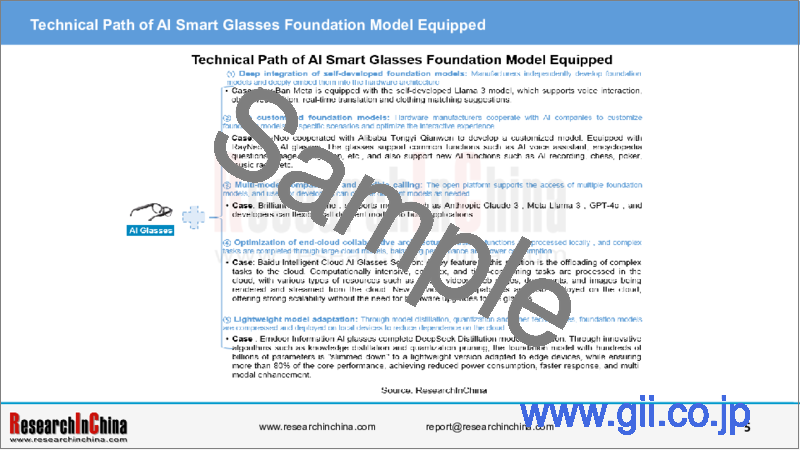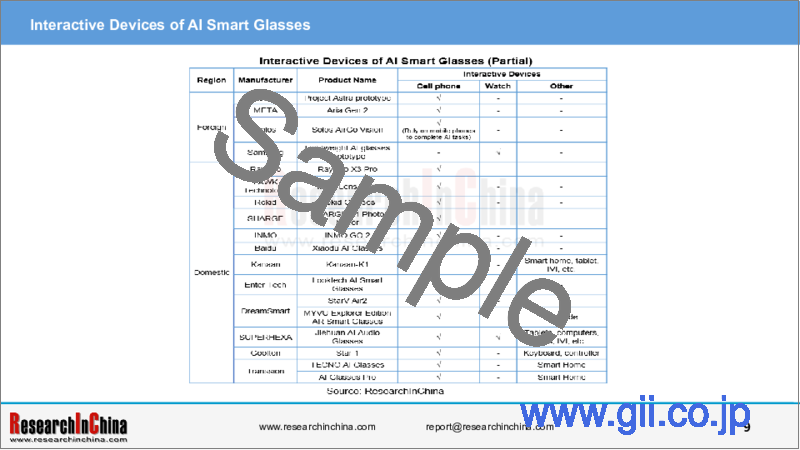|
|
市場調査レポート
商品コード
1694631
中国のAI/ARグラス産業(2025年)AI/AR Glasses Industry Research Report, 2025 |
||||||
|
|||||||
| 中国のAI/ARグラス産業(2025年) |
|
出版日: 2025年03月20日
発行: ResearchInChina
ページ情報: 英文 226 Pages
納期: 即日から翌営業日
|
全表示
- 概要
- 目次
1. 過去12ヶ月間に、主流メーカーは30を超えるAIスマートグラスを発売している
2024年~2025年、国内外の多くのメーカーがAIスマートグラスを発売し、特にCES2025の前後は市場が集中的な発売時期を迎えました。市場統計によると2024年、世界のAIスマートグラスの売上は約152万ペアで、そのうち中国のAIグラスブランドは約3%、わずか5万ペアでした。主要メーカーが技術研究開発と市場推進に引き続き力を注いでいるため、AIスマートグラス市場は将来的に大きく成長する可能性を秘めています。世界のAIスマートグラスの売上は、2030年までに9,000万ペアに急増し、コンシューマーエレクトロニクスの分野における無視できない成長ポイントになると推定されます。
技術的な観点から、一部のメーカーはAIスマートグラスにARディスプレイ機能を組み込み、仮想情報を現実のシーンと巧みに組み合わせ、より直感的で鮮明な方法でユーザーに提示し、AIグラスの応用シナリオと機能範囲を効果的に広げています。
重量の面では、AIグラスの全体的な重量は大きく異なり、25gという軽量のものから99gのものまであります。ほとんどの製品の重量は31g~70gの間に集中しています。軽量化の動向は、ハードウェア統合の大幅な改良を反映しています。
2. 30を超える主流モデルがあるAIグラス基盤モデルの5つの技術的経路
AIグラスはますます基盤モデルと結びついています。AIグラスメーカーと基盤モデルサプライヤー間の協力から、主に3つのコア戦略があります。
1. 完全に独立した基盤モデルの研究開発:このタイプのグラスメーカーは、技術のクローズドループを達成し、技術の自律性と制御性を確保することを目指し、独自に基盤モデルを構築する能力を持つ必要があります。
2. サードパーティサービスへのアクセス:APIやSDKを通じて外部の基盤モデルを呼び出すことができるため、グラスメーカーは迅速に機能を統合することができます。インタラクティブな体験を最適化するために、独自の基盤モデルを深くカスタマイズすることを選択するメーカーもあれば、ユーザーにオンデマンドで呼び出す柔軟性を与えるために、マルチモデルエコシステムを構築するメーカーもあります。
3.「自主開発+アクセス」のハイブリッド方式:この戦略は、技術の自主性と商品化効率のバランスを目指すものです。主なシナリオでは、メーカーは特定のニーズを満たすモデルを独自に開発し、一般的な機能については、サードパーティの基盤モデルにアクセスして迅速な展開を実現します。
つまり、AIグラスは、独自開発した基盤モデルの深い統合、特定のシナリオに向けたカスタマイズモデル、複数のモデルの互換性のある呼び出し、性能と消費電力を最適化するためのエンドクラウド連携戦略、ローカル展開を実現するための軽量化技術など、基盤モデルを搭載する際にさまざまな方法を使用します。
3. AIスマートグラスのエコシステム
AIグラスは「オールインワン統合」方式に基づいています。スピーカー、カメラ、バイオセンサー、ARディスプレイなどのコアコンポーネントを統合することで、近視グラス、スマートスピーカー、スポーツカメラ、電子書籍、プロジェクターなどの複数のデバイスの機能を巧みに組み合わせ、オーディオビジュアル、写真、ヘルスモニタリング、情報対話などのユーザーのニーズを満たし、ユーザーに便利で多様かつ効率的な体験をもたらします。
AIグラスは、ユーザーのために包括的でインテリジェントなエコロジカル相互接続環境を徐々に構築しています。その核心的価値はユーザー中心的であることにあり、効率的な相互接続技術とハイブリッドコンピューティングアーキテクチャに依存し、生活、仕事、エンターテインメントにおけるさまざまな端末(スマートフォン、コンピューター/キーボード、ゲームコントローラー、スマートホームデバイス、IVI端末など)をシームレスに接続します。
Kanaan Technologyは2024年12月31日、AIスマートグラス、KANAAN-K1を正式に発表しました。このグラスには音声アシスタントXiaonanが搭載されており、さまざまな端末と簡単に接続できます。ユーザーはXiaonanを起こすだけで、スマートホームのエコシステムにシームレスにアクセスし、室内の照明の明るさ、エアコンの温度、カーテンの開閉を自由に調整し、「サービスとしての音声」の便利な体験を完全に実現することができます。
当レポートでは、中国のAI/ARグラス産業について調査分析し、AIスマートグラスのコア技術、国内外の主要メーカーのレイアウト、開発動向などの情報を提供しています。
目次
第1章 AIスマートグラスの概要
- スマートグラスの一般的な分類と定義
- AIスマートグラス製品形式の定義
- AIスマートインタラクティブグラスの開発史
- AIスマートグラスの産業チェーン
- AIスマートグラスのコア用途シナリオ
- AIスマートグラスの市場規模
- 世界のAIスマートグラス市場の売上
- 世界のAIスマートグラス市場の売上:機能別
- 中国のAIスマートグラス市場の売上
- スマートウェアラブル製品の政策環境
- AIスマートグラスの特許研究開発(2023年~2025年)
第2章 AIスマートグラスのコア技術
- AIスマートグラスチップソリューションのサマリー
- AIスマートグラス向け光学ソリューションのサマリー
- AIスマートグラスディスプレイソリューションのサマリー
- AIスマートグラスのAIアルゴリズム
- AIスマートグラス用途向けの基盤モデルの比較
- AIスマートグラスのマルチモーダルインタラクション
第3章 国外の主要メーカーのAIグラスの動向
- Meta
- Brilliant Labs
- Solos
- Emteq Labs
- Samsung
第4章 中国の主要メーカーのAIグラスのレイアウト
- RayNeo
- LAWK Technology
- Rokid
- SHARGE Technology
- INMO Technology
- EmdoorVR
- Gyges Labs
- Baidu
- Goolton Technology
- Transsion
- DPVR
- Thundersoft
- Thunderobot
- Kanaan Technology
- Enter Tech
- その他のAIスマートグラス製品
第5章 スマートグラスOEM関連エコシステム企業のレイアウト
- DreamSmart
- Huawei
- Xiaomi
- SUPERHEXA
第6章 AIスマートグラス産業のサマリーと開発動向
- AIグラス:2024年~2025年に発売される製品のサマリー
- AIグラス:2024年~2025年に発売される製品モデル
- AIグラス:インタラクション方法のサマリーと動向
- AIグラス:インタラクション方法/デバイスの概要
- AIグラス:機能のサマリーと動向
- AIグラス:機能の概観的なレビュー
- AIグラス:基盤モデル搭載のサマリーと動向
- AIグラス:基盤モデルのレビュー
- 機能用途の動向1:スマートホームと車側の相互接続用途をカバーするマルチターミナル相互接続
- 機能用途の動向2:あらゆるシナリオでの使いやすさを実現する多機能統合
- 機能用途の動向3:マルチモーダル融合インタラクション、インテリジェントな共生に向けて
ResearchInChina released the " AI/AR Glasses Industry Research Report, 2025", which deeply explores the field of AI smart glasses, sorts out product R&D and ecological layout of leading domestic and foreign manufacturers, and analyzes OEM-related eco-chain enterprises in AI glasses field. It conducts a panoramic review of typical AI glasses products newly launched between 2024 and 2025, and presents their technical highlights and functional characteristics in multiple dimensions.
1. In the past 12 months, mainstream manufacturers have released more than 30 AI smart glasses
Between 2024 and 2025, many manufacturers at home and abroad have launched AI smart glasses, especially around the CES2025, the market ushered in an intensive release period. Market statistics show that in 2024, the global sales of AI smart glasses were about 1.52 million pairs, of which AI glasses brands in China accounted for about 3%, or only 50,000 pairs. As major manufacturers continue to exert their efforts in technology R&D and market promotion, the AI smart glasses market has great potential for future growth. It is estimated that by 2030, the global sales of AI smart glasses are expected to soar to 90 million pairs, becoming a growth point that cannot be ignored in the field of consumer electronics.
From a technical perspective, some manufacturers have incorporated AR display functions into AI smart glasses, cleverly combining virtual information with real scenes and presenting them to users in a more intuitive and vivid way, effectively broadening the application scenarios and functional scope of AI glasses.
In terms of weight, the overall weight of AI glasses varies greatly, ranging from as light as 25g to 99g. The weight of most products is concentrated between 31g and 70g. The trend of lightweight reflects the significant improvement in hardware integration.
2. Five technical paths for AI glasses foundation models, with more than 30 mainstream models
AI glasses are increasingly connected to foundation models. From the cooperation between AI glasses manufacturers and foundation model suppliers, there are mainly three core strategies:
1.Completely independent research and development of foundation models: This type of glasses manufacturer needs to have the ability to independently build foundation models, aiming to achieve a closed loop of technology and ensure the autonomy and controllability of the technology.
2.Access to third-party services: Through the ability to call external foundation models through API or SDK, glasses manufacturers can quickly integrate functions. Some manufacturers choose to deeply customize their own foundation models to optimize the interactive experience; while others build a multi-model ecosystem to give users the flexibility to call on demand.
3."Self- developed + access" hybrid modes: This strategy aims to balance the autonomy of technology and commercialization efficiency. In key scenarios, manufacturers will independently develop models to meet specific needs; for general functions, they will access third-party foundation models to achieve rapid deployment.
In short, AI glasses use a variety of methods when equipped with foundation models, including deep integration of self- developed foundation models, customized models for specific scenarios, compatible calls of multiple models, end-cloud collaborative strategies to optimize performance and power consumption, and lightweight technology to achieve local deployment.
3. AI smart glasses ecosystem
AI glasses are based on the "all-in-one integration" mode. By integrating core components such as speakers, cameras, biosensors, AR displays, etc., they cleverly combine functions of multiple devices such as myopia glasses, smart speakers, sports cameras, e-books, projectors, etc., to meet users' needs in audio-visual, photo, health monitoring, information interaction, etc., bringing users a convenient, diverse and efficient experience.
AI glasses are gradually building a comprehensive, intelligent ecological interconnected environment for users. Its core value lies in being user-centric, relying on efficient interconnection technology and hybrid computing architecture to seamlessly connect various terminals in life, work, and entertainment (such as smartphones, computers/keyboards, game controllers, smart home devices, and IVI terminals).
Kanaan Technology officially released the KANAAN-K1 AI smart glasses on December 31, 2024. The glasses are equipped with voice assistant "Xiaonan", which can easily connect to various terminals. Users only need to wake up "Xiaonan" to seamlessly access smart home ecosystem, freely adjust the brightness of indoor lights, the temperature of air conditioners, and the opening and closing of curtains, and fully realize the convenient experience of "voice as a service".
4. Application prospects of AI glasses in vehicles
DreamSmart's AR+AI smart glasses, powered by the Flyme AI OS and Flyme Link technology, enable seamless connectivity and smooth switching across multiple devices (including smartphones, IVI systems, and other terminals) in all scenarios, delivering a boundless intelligent experience.
AI glasses technology is accelerating its iteration, and the standardized system platforms and interconnection technologies built by major manufacturers are becoming more mature, which gives AI glasses a broad application prospect in automotive field.
As seen from the above functions, AI glasses and AR-HUD share some overlapping functionalities. However, AI glasses far surpass AR-HUD in terms of virtual display size, display richness, multimodal interaction capabilities, and upgradability.
Beyond enabling "display enhancement" in the cockpit, AI glasses can also provide "computing power enhancement." With the advancement of foundation models, smart cockpits are demanding increasingly higher computing power. Upgrading the built-in IVI system's computing capacity is often challenging, whereas some AI glasses come equipped with a computing power module that can enhance the cockpit's processing capabilities.
Table of Contents
Preface
Related Definitions
1 Overview of AI Smart Glasses
- 1.1 General Classification and Definition of Smart Glasses
- 1.2 Definition of AI Smart Glasses Product Form
- 1.3 Development History of AI Smart Interactive Glasses
- 1.4 Industry Chain of AI Smart Glasses
- 1.5 Core Application Scenarios of AI Smart Glasses
- 1.6 Market Size of AI Smart Glasses
- Market Sales of Global AI Smart Glasses
- Market Sales of Global AI Smart Glasses by Function
- Market Sales of China's AI Smart Glasses
- 1.7 Policy Environment for Smart Wearable Products
- 1.8 Patent Research and Development of AI Smart Glasses (2023-2025)
2 Core Technologies of AI Smart Glasses
- 2.1 Summary of AI Smart Glasses Chip Solutions
- System-level SoC solution
- MCU-level SoC + ISP solution
- SOC + MCU Solution
- Comparison of AI Smart Glasses Chip Solutions
- 2.2 Summary of Optical Solutions for AI Smart Glasses
- BirdBath Optical Solutions
- BirdBath Optical Solutions: Supplier Solutions
- BirdBath Optical Solutions: Smart Glasses Application
- Optical Waveguide Technology Summary
- Optical Waveguide Technology (1): Geometric Waveguide
- Optical Waveguide Technology (1): Geometric Optical Waveguide Supplier Solutions and Applications
- Optical Waveguide Technology (2): Diffractive Waveguide - Surface Relief Grating Waveguide
- Optical Waveguide Technology (3): Diffractive Waveguide - Volume Holographic Waveguide
- Optical Waveguide Technology (3): Diffractive Optical Waveguide for Smart Glasses Applications
- 2.3 Summary of AI Smart Glasses Display Solutions
- Near-Eye Optical Display System of Smart Glasses
- LCoS Display Solution
- DLP Display Solution
- LBS Display Solution
- Micro OLED Display Solution
- Micro LED Display Solution
- 2.4 AI Algorithm of AI Smart Glasses
- 2.5 Comparison of Foundation Models for AI Smart Glasses Applications
- 2.6 Multimodal Interaction of AI Smart Glasses
3. AI Glasses Layout of Major Foreign Manufacturers
- 3.1 Google
- Smart Glasses Development History
- Smart Glasses Layout: Multiple Acquisitions Help Google Enter the XR Smart Glasses Field
- Release of New Android XR Operating System
- Multimodal Foundation Model Gemini 2.0
- Launch of Multimodal AI Assistant Project Astra, Integrated into New Smart Glasses
- 3.2 Meta
- Profile
- AI Smart Glasses Cost Structure
- AI Smart Glasses Products (1)
- AI Smart Glasses Products (2)
- AR+AI Smart Glasses Products
- 3.3 Brilliant Labs
- Profile
- AR+AI Smart Glasses Products
- Developer Partner Program
- 3.4 Solos
- Profile
- AI Smart Glasses Products
- 3.5 Emteq Labs
- Profile
- AI Smart Glasses Solution
- AI Smart Glasses
- 3.6 Samsung
- AI Smart Glasses Layout (1)
- AI Smart Glasses Layout (2)
4. AI Glasses Layout of Major Chinese Manufacturers
- 4.1 RayNeo
- Profile
- AI + AR Ecosystem Architecture
- AI+AR glasses products: X3 series
- AI photography glasses products: V3 AI Photography Glasses
- AR+AI Smart Glasses Products (1)
- AR+AI Smart Glasses Products (2)
- Establish Joint Venture with Doctorglasses To Develop AI Glasses
- Reach Exclusive Strategic Cooperation with Alibaba Cloud In AI Glasses
- 4.2 LAWK Technology
- Profile
- Smart Glasses Layout
- AI Smart Glasses Product Series
- AI Smart Glasses
- Smart Glasses Cooperation Dynamics
- 4.3 Rokid
- Profile
- AR Space Operating System
- AR+AI Smart Glasses Products
- Smart Glasses Ecosystem Cooperation
- 4.4 SHARGE Technology
- Profile
- AI Smart Glasses Layout
- AI Photography Glasses: SHARGE A1 Photo Glasses
- Launches Overseas Version of AI Glasses Brand and Products
- Status Quo of AI Glasses Product Delivery
- 4.5 INMO Technology
- Profile
- Builds AI+AR Industry Ecosystem
- AI Smart Glasses Product Series
- AI Smart Glasses
- AR+AI Smart Glasses
- 4.6 EmdoorVR
- Profile
- "AI + Strategy" Layout
- AI Glasses Rapid Productization System
- AI Glasses Full-Link Solution
- AI+AR Product Planning
- AI Glasses Cooperation Dynamics
- 4.7 Gyges Labs
- Profile
- Core Technology
- Jointly Launch AI Smart Glasses with Moody
- Halliday AR+AI Smart Glasses
- 4.8 Baidu
- Profile
- AI Smart Glasses
- AI Smart Glasses Technology Base
- AI Glasses Foundation Model Interactive Solution of Baidu Intelligent Cloud
- Qianfan Foundation model Platform of Baidu Intelligent Cloud
- Smart Glasses Cooperation Dynamics of Baidu Intelligent Cloud
- 4.9 Goolton Technology
- Profile
- Optical Module Products
- Launches Multimodal AI Platform
- AR + AI Smart Glasses
- 4.10 Transsion
- Profile
- Launches AI Smart Glasses Product
- AI Smart Glasses
- AR + AI Smart Glasses
- Cooperation Dynamics of AI
- 4.11 DPVR
- Profile
- AI Smart Glasses
- AI Smart Glasses Cooperation Dynamics
- 4.12 Thundersoft
- Profile
- AI Glasses Solution
- Lightweight AI Glasses of Thundercomm
- 4.13 Thunderobot
- Profile
- AI Smart Glasses Products
- 4.14 Kanaan Technology
- Profile
- AI Smart Glasses
- 4.15 Enter Tech
- Profile
- AI Smart Glasses
- 4.16 Other AI Smart Glasses Products
- Other AI Smart Glasses Products (1)
- Other AI Smart Glasses Products (2)
- Other AI Smart Glasses Products (3)
5 Smart Glasses Layout of OEM-related Ecosystem Enterprises
- 5.1 DreamSmart
- Profile
- ALL in AI Development Strategy
- AR+AI Smart Glasses Products (1)
- AR+AI Smart Glasses Products (2)
- AR+AI Smart Glasses Products (3)
- AR+AI Smart Glasses & Vehicle-Side Fusion Applications
- Smart Glasses Cooperation Dynamics
- 5.2 Huawei
- Profile
- Ecosystem Strategy: Building a Harmony World Based on Five Scenarios and Innovative Technologies
- Ecosystem Strategy: 1+8+N Full-Scenario Strategy
- Smart Wearable Technology Brand: Xuanji Sensing System
- AI Smart Glasses Products
- 5.3 Xiaomi
- Ecosystem Strategy
- Smart Glasses Product Iteration Process
- AI Smart Glasses Specifications Forecast
- AI Smart Glasses BOM Forecast
- 5.4 SUPERHEXA
- Profile
- Smart Glasses Product Series
- AI Audio Glasses Products
- Jiehuan AI Framework
- Smart Glasses Cooperation Dynamics
6 Summary and Development Trends of AI Smart Glasses Industry
- 6.1 AI Glasses: Summary of Products Launched in 2024-2025
- 6.2 AI Glasses: Product Models Launched in 2024-2025
- 6.3 AI Glasses: Summary and Trend of Interaction Methods
- 6.4 AI Glasses: Overview of Interaction Methods / Device
- 6.5 AI Glasses: Functional Summary and Trends
- 6.6 AI Glasses: Panoramic Review of Functions
- 6.7 AI Glasses: Summary and Trends of Foundation Model Installation
- 6.8 AI Glasses: Review of Foundation Models
- 6.9 Functional Application Trend 1: Multi-terminal Interconnection, Covering Smart Home and Car-Side Interconnection Applications
- 6.10 Functional Application Trend 2: Multi-function Integration to Achieve Full-Scenario Usability
- 6.11 Functional Application Trend 3: Multimodal Fusion Interaction, Towards Intelligent Symbiosis





